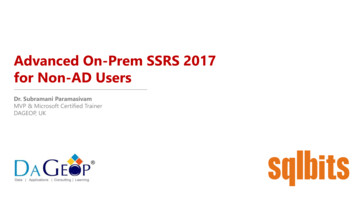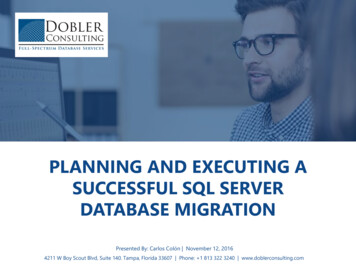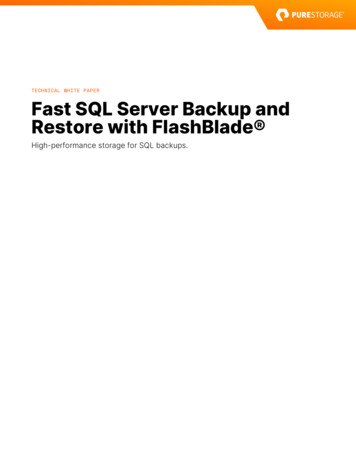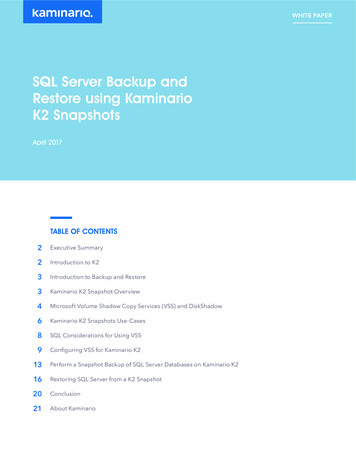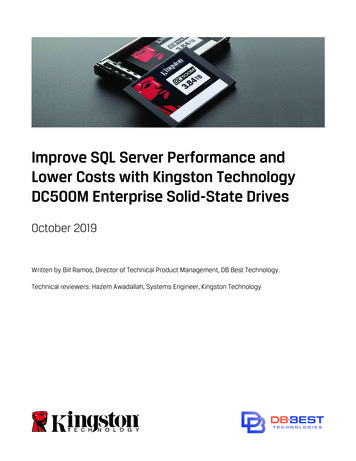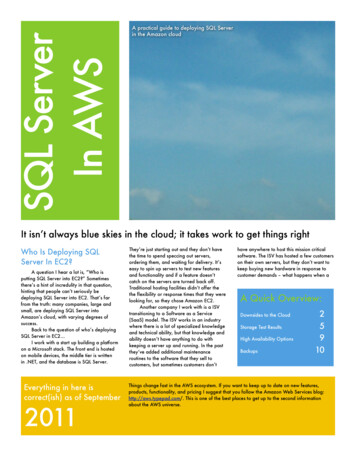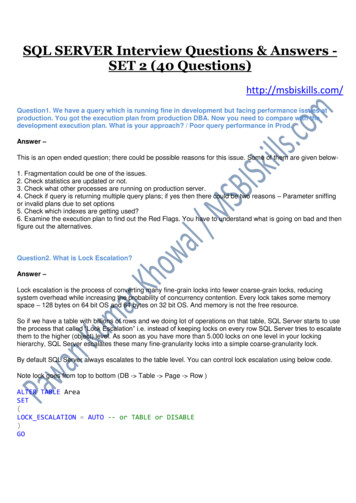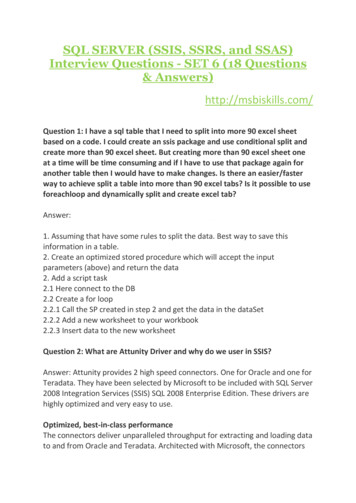
Transcription
SQL SERVER (SSIS, SSRS, and SSAS)Interview Questions - SET 6 (18 Questions& Answers)http://msbiskills.com/Question 1: I have a sql table that I need to split into more 90 excel sheetbased on a code. I could create an ssis package and use conditional split andcreate more than 90 excel sheet. But creating more than 90 excel sheet oneat a time will be time consuming and if I have to use that package again foranother table then I would have to make changes. Is there an easier/fasterway to achieve split a table into more than 90 excel tabs? Is it possible to useforeachloop and dynamically split and create excel tab?Answer:1. Assuming that have some rules to split the data. Best way to save thisinformation in a table.2. Create an optimized stored procedure which will accept the inputparameters (above) and return the data2. Add a script task2.1 Here connect to the DB2.2 Create a for loop2.2.1 Call the SP created in step 2 and get the data in the dataSet2.2.2 Add a new worksheet to your workbook2.2.3 Insert data to the new worksheetQuestion 2: What are Attunity Driver and why do we user in SSIS?Answer: Attunity provides 2 high speed connectors. One for Oracle and one forTeradata. They have been selected by Microsoft to be included with SQL Server2008 Integration Services (SSIS) SQL 2008 Enterprise Edition. These drivers arehighly optimized and very easy to use.Optimized, best-in-class performanceThe connectors deliver unparalleled throughput for extracting and loading datato and from Oracle and Teradata. Architected with Microsoft, the connectors
use direct integration into internal SSIS buffering APIs, cutting through .NETand other layers, and also use the high speed load/extract utilities offered byOracle and Teradata.Ease-of-useThe connectors are fully integrated into the Business Intelligence DevelopmentStudio (BIDS), part of Microsoft Visual Studio 2008, offering a user experiencesimilar to that of the SSIS generic OLEDB Connector, with intuitive capabilitiesincluding configuration, metadata browsing, and error routing.Question 3: How many type of protection level in SSIS package?Answer:It is a package level property. It is used to specify how sensitive information issaved inside the package. It also specify whether to encrypt the package or thesensitive portions of the package.Each SSIS component designates that an attribute is sensitive by includingSensitive ”1″ in the package XML. When the package is saved, any propertythat is tagged with Sensitive ”1″ gets handled per the ProtectionLevel propertysetting in the SSIS package. The ProtectionLevel property can be selected fromthe following list of available options (click anywhere in the design area of theControl Flow tab in the SSIS designer to show the package properties): DontSaveSensitive EncryptSensitiveWithUserKey EncryptSensitiveWithPassword EncryptAllWithPassword EncryptAllWithUserKey ServerStorageQuestion 4: Difference between Cached Report and Snapshot Report?Answer:Cached ReportHere the system will save the last executed report. It is saved in the temp DB. Itis not persisted. It has a lifetime e.g. 1 hour or so. We can have 1 only one“instance” per report (if you have parameters, you will have one percombination of parameter)Snapshot Report
It is a persisted copy of the report. It is stored for good on the report database.You can have as many as you want. You can configure for example to save asnapshot of a report per day, so if you want to see how your data was 1 monthago, you just access the snapshot of that day.When to use which oneMost of my reports, I cache them for 2 hours, so the first user who runs it willexperience a small delay and the next will get the report on demand (with thedata from when the report was ran, of course)For large reports, execute them at night and configure them to be run from asnapshot (option “Render this report from a report execution snapshot”).Question 5: What are check point and how they work?Answer:SSIS 2005 included a feature called checkpoints, which allows you to restartthe package if it fails for any reason. During package execution, the lastsuccessfully completed task or container is noted in a checkpoint file, and thecheckpoint file is removed if the package completes successfully. But if thepackage fails before completing, the checkpoint file remains available as areference to the location from which to restart the package.You need to set three package properties:CheckpointFileName. For this property, you need to provide a path andfilename for the checkpoint file. If you plan to keep checkpoints implementedwhen you put a package into production, it’s a good idea to use a UniversalNaming Convention (UNC) path.CheckpointUsage. This property has three possible values: Never, Always, andIfExists. The default is Never, which prevents checkpoint creation. When youspecify the Always option, the package uses the checkpoint file if it exists. If itdoesn’t exist, the package fails. Therefore, the Always option isn’trecommended for a package in production because the package shouldn’t befailing regularly. (A package failure is the only way a checkpoint file getscreated. Once the package completes successfully, the checkpoint file isremoved.) The best option to use is IfExists. When you select this option, the
package uses the checkpoint file if it exists. If it doesn’t exist, the programstarts from the beginning of the package.SaveCheckpoints. This property must be set to true. Otherwise, the previoussettings won’t have any effect. By default, it’s set to False.For details please refer – estart-failed-ssis-packagesQuestion 6: How check point works in for loop?Answer:The Foreach Loop container is another atomic unit of work that can berestarted. However, the checkpoint file does not contain information about thework completed by the child containers, and the Foreach Loop container andits child containers run again when the package restarts.Question 7: Can we apply style sheet in SSRS and how?Answer:There are two ways to apply style sheet in SSRS1. Hard Code in RDL File2. Dynamically – You can save your style in DB and pull that in a DataSet andthen apply.For details please refer o-implement-style-sheets-in-your.htmlQuestion 8: How to show “No Data Found” Message to end user?Answer:Add a text box. Set expression of the text box IIF(Count(,”DataSet1″) 0,”NoData Found”, Nothing)and set the visibility of this text box IIF(Count(,”DataSet1″) 0,False,True)
Question 9 : Sometime we need to debug out SSIS Package but we do notwant to insert records in destination but still we want to use all thetransformations and dump these all records in some dummy destination. Thegoal can be to check the extraction performance from source OR view data atdifferent points of Package but we do not want to insert data in destinationat all.Answer:In this kind of scenario you can use below solutions1. Multicast transformation2. Row Count TransformationQuestion 10: Can we debug SSIS package. If Yes, How?Answer:You can debug a Package by Setting Breakpoints on a Task or a ContainerTo set breakpoints in a package, a task, or a container follow below In SQL Server Data Tools (SSDT), open the Integration Services project thatcontains the package you want. Double-click the package in which you want to set breakpoints.In SSIS Designer, do the following: To set breakpoints in the package object, click the Control Flow tab, placethe cursor anywhere on the background of the design surface, right-click,and then click Edit Breakpoints. To set breakpoints in a package control flow, click the Control Flow tab,right-click a task, a For Loop container, a Foreach Loop container, or aSequence container, and then click Edit Breakpoints. To set breakpoints in an event handler, click the Event Handler tab, rightclick a task, a For Loop container, a Foreach Loop container, or a Sequencecontainer, and then click Edit Breakpoints. In the Set Breakpoints dialog box, select the breakpoints to enable.Optionally, modify the hit count type and the hit count number for eachbreakpoint. To save the package, click Save Selected Items on the File menu.Question 11: How to create Temporary Table using SSIS?Answer:
You can use Execute SQL task to create temp table and set the propertyRetainSameConnection on the Connection Manager to true so that temporarytable created in one Control Flow task can be retained in another task.Question 12: We get the files in our Source Folder all day long. Each file isappended copy of previous file. We want to create a SSIS Package that willload only the most recent file to our table?Answer:It’s simple create 2 variables, folderpath and filename. Now in script task,create a loop and find out the latest file. Now you can read the latest file in thescript task itself and insert the data into the table.For details please refer – et-most-recent-file-from.htmlQuestion 13: What are Lazy aggregations?Answer:Processing mode property of a partition/measure group determines howpartitions will be available to users. Processing mode has two possible options– Regular and Lazy Aggregations.Regular – Default. When set to regular, partitions will be available to usersafter data has been loaded and aggregations are created completely.Lazy Aggregations – When set to lazy aggregations, partitions will be availableto user queries immediately after data has been loaded. Aggregations will becreated as a separate background process while users start to query thepartition.Process Full will internally executes Process Data and Process Index before thepartition can be used for queries. If processing mode is set to LazyAggregations, partition will be released for user queries after Process Data iscompleted. Process Index will be executed in the background. As aggregationsdon’t exist while users begin to query the partition they may experience slowperformance.
Question 14: How we can ignore failure and continue loop?Answer:The Propagate variable in SSIS is used to determine whether an event ispropagated to a higher level event handler. This allows package execution tocontinue once an event is handled in the container that has generated ntinue-a-foreach-loop-containerQuestion 15: What are Partition processing options?Answer:When you process objects in Microsoft SQL Server Analysis Services, you canselect a processing option to control the type of processing that occurs foreach object. Processing types differ from one object to another, and bychanges that have occurred to the object since it was last processed. If youenable Analysis Services to automatically select a processing method, it will usethe method that returns the object to a fully processed state in the least time.Processing settings let you control the objects that are processed, and themethods that are used to process those objects.ModeProcessDefaultApplies toDescriptionCubes, databases,dimensions,measure groups,mining models,mining structures,and partitions.Detects the processstate of databaseobjects, andperforms processingnecessary to deliverunprocessed orpartially processedobjects to a fully
processed state. Ifyou change a databinding, ProcessDefault will do aProcess Full on theaffected object.Cubes, databases,dimensions,measure groups,mining models,mining structures,and partitions.Processes an AnalysisServices object andall the objects that itcontains. WhenProcess Full isexecuted against anobject that hasalready beenprocessed, AnalysisServices drops alldata in the object,and then processesthe object. This kindof processing isrequired when astructural change hasbeen made to anobject, for example,when an attributehierarchy is added,deleted, or renamed.ProcessClearCubes, databases,dimensions,measure groups,mining models,mining structures,and partitions.Drops the data in theobject specified andany lower-levelconstituent objects.After the data isdropped, it is notreloaded.ProcessDataDimensions,cubes, measuregroups, andpartitions.Processes data onlywithout buildingaggregations orindexes. If there isProcessFull
data is in thepartitions, it will bedropped before repopulating thepartition with nsions,measure groups,and partitions.Process Add is notavailable fordimensionprocessing inManagementStudio, but youcan write XMLAscript performsthis action.For dimensions, addsnew members andupdates dimensionattribute captionsand descriptions.DimensionsForces a re-read ofdata and an updateof dimensionattributes. Flexibleaggregations andindexes on relatedpartitions will bedropped.Cubes,dimensions,measure groups,and partitionsCreates or rebuildsindexes andaggregations for allprocessed partitions.For unprocessedobjects, this optiongenerates an error.Processing with thisoption is needed ifyou turn off LazyProcessing.
ProcessStructureProcessClearStructureCubes and miningstructuresIf the cube isunprocessed,Analysis Services willprocess, if it isnecessary, all thecube’s dimensions.After that, AnalysisServices will createonly cube definitions.If this option isapplied to a miningstructure, itpopulates the miningstructure with sourcedata. The differencebetween this optionand the Process Fulloption is that thisoption does notiterate the processingdown to the miningmodels themselves.Mining structuresRemoves all trainingdata from a miningstructure.For details please refer – spxQuestion 16: How to make connection with SFTP server?Answer:SFTP stands for Secure File Transfer Protocol which is a worldwide acceptedsecure protocol to transfer and access files over a secure channel. The dataand channel are encrypted in SFTP
SQL SERVER (SSIS, SSRS, and SSAS) Interview Questions - SET 6 (18 Questions & Answers) http://msbiskills.com/ Question 1: I have a sql table that I need to split into more 90 excel sheet based on a code. I could create an ssis package and use conditional split and create more than 90 excel sheet. But creating more than 90 excel sheet one


